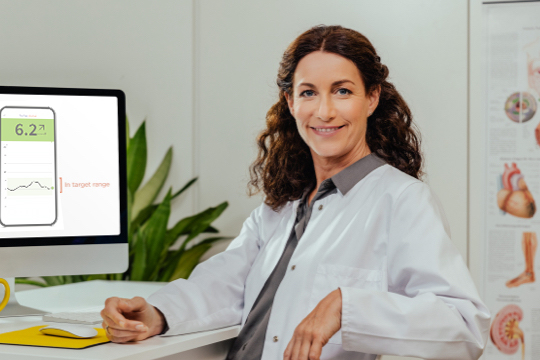Increased Monitoring Frequency
Increased glucose monitoring frequency is strongly associated with better diabetes self-management36,37
Reduced HbA1c
The FreeStyle Libre systems are clinically proven to significantly reduce HbA1c in patients with T2D38,39
Overall 0.9% (9.7 mmol/mol) HbA1c reduction in patients with T2D on basal bolusinsulin38
(p <0,0001)
43% increase in time in target range
(3,9 - 10,00 mmol/L) from 11,7 to 16,8 hours per day with increased scanning frequency37
(p<0,001)
63% reduction in time spent in hyperglycemia
across patients with T1D and T2D37
(p<0,001)
43% reduction of time spent in hypoglycemia
in patients with T2D17
(p<0,0006)
Making Better Choices
The FreeStyle Libre portfolio helps patients with diabetes make better choices
Real world data showed that 95 % of patients with T1D and T2D that use the FreeStyle Libre systems:
Have a better understaning of their glucose fluctuations40

Improved Glycaemic Control in Children15,27
Increased time in range (3.9-10.0 mmol/L) by 1 hour/day27
Reduced HbA1c by 0.4% (4.4 mmol/mol)27
Increased the frequency of glucose monitoring to an average of 13x /day27
Reduced time spent in hypergycemia
(>10 mmol/L) by 1 hr/day with no significant increase in time spent in hypoglycemia (<3.9 mmol/L)27
Additional Resources
Diabetes triangle
The FreeStyle portfolio helps patients learn and understand the three key areas for improving their diabetes treatment
Training Resources
Explore our training resources to help you to help your patients understand Time in Range better.
Webinars
See our webinars for Healthcare Professionals
References & Disclaimers
Images are for illustrative purposes only. Not real patient or data.
15. For children aged 4-12, a caregiver at least 18 years old is responsible for supervising, managing, and assisting them in using the FreeStyle Libre system and interpreting its readings.
17. Haak, Thomas., et al. Flash glucose-sensing technology as a replacement for blood glucose monitoring for the management of insulin-treated type 2 diabetes: a multicenter, openlabel randomized controlled trial. DiabetesTherapy 8.1 (2017): 55–73..
20. Jan Bolinder, Ramiro Antuna, Petronella Geelhoed-Duijvestjin, Jens Kröger, Raimund Weitgasser. “Novel Glucose-Sensing Technology and Hypoglycaemia in Type 1 Diabetes: a Multicentre, Non-Masked, Randomised Controlled Trial.” Lancet 388, no. 10057 (2016): 2254–2263. https://doi.org/10.1016/S0140-6736(16)31535-5.
27. Campbell FM, et al. Outcomes of using flash glucose monitoring technology by children and young people with type 1 diabetes in a single arm study. Pediatr Diabetes 2018;19(7):1294–301.
36. Dunn, T., et al. Real-world flash glucose monitoring patterns and associations between self-monitoring frequency and glycaemic measures: A European analysis of over 60 million glucose tests. Diabetes Research and Clinical Practice; 137(2018) 37-46
37. Lang J, et al. Expanded real-world use confirms strong association between frequency of flash glucose monitoring and glucose control [Poster 972]. Diabetes 2019 Jun; 68(Supplement 1). https://doi.org/10.2337/db19- 972-P.
38. Kröger J, et al. Three European retrospective real-world chart review studies to determine the effectiveness of flash glucose monitoring on HbA1c in adults with type 2 diabetes. Diabetes Ther 2020;11(1):279–91.
39. Yaron M, et al. Effect of flash glucose monitoring technology on glycemic control and treatment satisfaction in patients with type 2 diabetes. Diabetes Care 2019;42(7):1178–84.
40. Fokkert M, van Dijk P, Edens M, et al. Improved well-being and decreased disease burden after 1-year use of flash glucose monitoring (FLARE-NL4). BMJ Open Diab Res Care. 2019. https://doi:10.1136/bmjdrc-2019-000809
ADC-92113 v1 08/24

